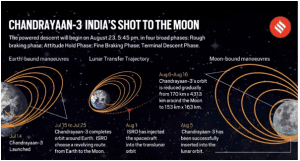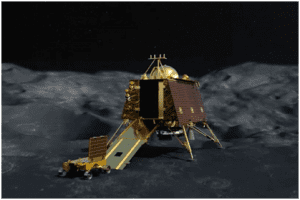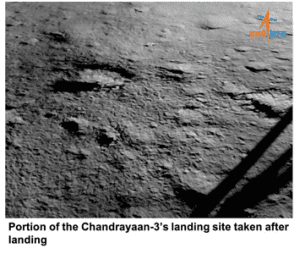1. CHANDRAYAAN-3
TAG: GS 3: SCIENCE AND TECHNOLOGY
THE CONTEXT: India’s Moon mission Chandrayaan-3 scripted history by successfully landing on the lunar surface at 6:04 pm on 23rd August, 2023.
EXPLANATION:
- India becomes the only country to have accomplished a ‘soft landing’ on the Moon’s south pole and a rover, which is a small vehicle came out of the Lander.
- According to ISRO, the mission’s three objectives were to
- Demonstrate a safe and soft landing on the lunar surface
- To demonstrate a Rover roving on the Moon
- To conduct in-situ scientific experiments.
What is a soft landing, and why did Chandrayaan-3 land on the south pole?
- Soft landing simply means landing at a gentle, controlled speed to not sustain damage to a spacecraft. It showcases a spacecraft’s technical capabilities.
- Chandrayaan’s 3 landing site is near the south pole of the moon at 70 degrees latitude.
- All of the previous spacecraft to have landed on the Moon have landed in the region near the Moon’s equator, firstly because it is easier and safer here. The terrain and temperature are more conducive for a long and sustained operation of instruments. Sunlight is also present, offering a regular supply of energy to solar-powered instruments.
- The polar regions of the Moon, however, are different. Many parts lie in a completely dark region without sunlight, and temperatures can go below 230 degrees Celsius. This creates difficulty in the operation of instruments. In addition, there are large craters all over the place.
- As a result, the polar regions of the Moon have remained unexplored. The extremely cold temperatures could mean that anything trapped in the region would remain frozen in time, without undergoing much change. The rocks and soil in Moon’s north and south poles could therefore provide clues to the early Solar System.
- Notably, Chandrayaan-2 also planned to land in this region in 2019, but it was not able to accomplish a soft landing and lost contact after it hit the surface.


How did Chandrayaan-3 landed successfully?
- Chandrayaan-3 Lander performed the critical technical manoeuvre when it entered the final 15 minutes of its attempt to make a soft landing on the Moon, where it had to transfer its high-speed horizontal position to a vertical one in order to facilitate a gentle descent on to the surface.
- It includes four phases:
- Rough Braking phase: This phase includes reducing the lander’s horizontal velocity from a range of 1.68 km/sec (more than 6,000 km/h) at a height of 30 km from the lunar surface, to almost zero for a soft landing at the designated site. This has to be done with precision, within certain durations. 2.
- Attitude hold phase: At a height of 7.42 km from the surface, the lander is to go into an “attitude hold phase” lasting around 10 seconds, during which it should tilt from a horizontal to a vertical position while covering a distance of 3.48 km.
- Fine braking phase: This phase lasts around 175 seconds, during which the lander is to move fully into a vertical position. It is to traverse the final 28.52 km to the landing site, the altitude will come down to 800-1,000 m, and it would reach a nominal speed of 0 m/sec. It was between the “attitude hold phase” and the “fine braking phase” that Chandrayaan-2 lost control and crashed.
- Terminal descent phase: This is the final stage, when the spacecraft is supposed to descend totally vertically onto the surface.
After Chandrayaan-3’s successful landing on the Moon:
- Chandrayaan is carrying certain instruments and experiments with them called payloads that observe and record what is happening in Space. This information is then relayed to Earth for scientists to analyse and study.
- The six payloads on the Vikram lander and rover Pragyan remain the same as the previous mission.
- There will be four scientific payloads on the lander to study lunar quakes, thermal properties of the lunar surface, changes in the plasma near the surface, and a passive experiment to help accurately measure the distance between Earth and the Moon.
- The fourth payload comes from NASA.
- There are two payloads on the Rover, designed to study the chemical and mineral composition of the lunar surface and to determine the composition of elements such as magnesium, aluminium and iron in the lunar soil and rocks.
2. PRAGYAN ROVER AND VIKRAM LANDER
TAG: GS 3: SCIENCE AND TECHNOLOGY
THE CONTEXT: Chandrayaan-3’s Pragyan rover ramped down from the Vikram Lander. The rover will stay on the lunar surface for 1 Lunar day or 14 Earth days.
PRAGYAN ROVER AND VIKRAM LANDER


- Chandrayaan-3 successfully soft-landed on the Moon’s southern pole, beginning a new phase of lunar exploration.
- This lunar mission comprises a propulsion module weighing 2,148 kg and a lander module of 1,752 kg (Vikram Lander), accompanied by a 26 kg rover (Pragyan rover).
- The Pragyan rover will conduct a series of experiments on the surface of the moon.
- Pragyan will check the chemical composition of the lunar surface and examine the lunar soil and rocks.
- It will measure the ions and electrons density and the thermal properties of the lunar surface near the polar region.
- This will be the first of its kind study as no other country has ever ventured to the moon’s south pole.
- This data will then be relayed to the Vikram lander, which will subsequently transmit these data back to Earth for thorough scientific study.
What will happen to Chandrayaan-3 after 14 days?
- A significant alteration occurs as the 14-day lunar day comes to an end. The Moon enters a 14-day night that is known for its bone-chilling cold.
- This extreme condition renders both the Vikram lander and the Pragyan rover
- ISRO has designed its lander and rover to harness solar power and charge its onboard batteries, but that would be possible only during the lunar day.
- After lunar day, comes lunar night for 14 days when temperatures drop severely and go well below -150ºC.
- If the lander and rover survive the lunar night (14.75 earth days), it might be possible for them to get revived when the lunar day breaks and solar power is available.
3. INDIAN SPACE RESEARCH ORGANISATION’S TELEMETRY, TRACKING AND COMMAND (ISTRAC) AND MISSION OPERATIONS COMPLEX (MOX)
TAG: GS 3: SCIENCE AND TECHNOLOGY
THE CONTEXT: The Indian Space Research Organisation (ISRO) confirmed that the communication link has been established between the Chandrayaan-3 Lander and MOX-ISTRAC, Bengaluru after the India’s lunar satellite’s soft landing.
What is the role of ISTRAC and MOX?
- ISTRAC:
- The Indian Space Research Organisation’s Telemetry, Tracking and Command centre in Bengaluru will receive data from the spacecraft and provide command tracking support.
- It provides telemetry, tracking and command services from the time a rocket launches with a satellite or spacecraft to injection of the satellite into orbit and through the lifespan of the satellite.
- It has a network of ground stations at Bengaluru, Lucknow, Mauritius, Sriharikota, Port Blair, Thiruvananthapuram, Brunei, and Biak (Indonesia) and Deep Space Network stations.
- It is networked with a Deep Space Network established outside Bengaluru for ISRO’s deep space mission and will also be linked to ground stations of the Jet Propulsion Laboratory of the US and the European Space Agency for Chandrayaan-3.
- MOX:
- MOX consists of a Mission Control Room and a Mission Analysis Room.
- It is the centre from where scientists will monitor the spacecraft 24×7.
- There are two MOX complexes at ISTRAC.
- It has been managing the health and other flight parameters of the spacecraft since Chandrayaan-3’s launch.
- The MOX facilities were first set up at ISTRAC for the Chandrayaan-1 fly-by-the-moon mission in 2008.
- It can accommodate over 100 scientists to monitor a spacecraft.
- It resembles an operation theatre, with scientists seated on either side of a gallery poring over streams of data from a spacecraft.
- Spacecraft are monitored for over 1,000 parameters to assess their overall health.
The image captured by the Landing Imager Camera after the landing. It shows a portion of Chandrayaan-3’s landing site.


Indian Space Research Organisation (ISRO):
- Indian Space Research Organisation (ISRO) is the space agency of India.
- ISRO was previously the Indian National Committee for Space Research (INCOSPAR), set up by the Government of India in 1962, as envisioned by Dr. VikramA Sarabhai.
- ISRO was formed on August 15, 1969, and superseded INCOSPAR with an expanded role to harness space technology.
- Department of Space (DOS) was set up and ISRO was brought under DOS in 1972.
- The organisation is involved in science, engineering, and technology to harvest the benefits of outer space for India and the mankind.
- It is a major constituent of the Department of Space (DOS), Government of India. The department executes the Indian Space Programme primarily through various Centres or units within ISRO.
- The prime objective of ISRO is the development and application of space technology for various national needs.
- To fulfil this objective, ISRO has established major space systems for communication, television broadcasting and meteorological services; resources monitoring and management; space-based navigation services.
- ISRO has developed satellite launch vehicles, PSLV and GSLV, to place the satellites in the required orbits.
4. NASA’S DEEP SPACE NETWORK AND CHANDRAYAAN
TAG: GS 3: SCIENCE AND TECHNOLOGY
THE CONTEXT: In addition to ISRO’s own deep space communication antenna, the Chandrayaan-3 mission has been relying on support from ground stations around the world, coordinated by NASA.
EXPLANATION:
- India joined an elite group of three nations to have sent a spacecraft on the moon as Chandrayaan-3 landed a rover on the lunar surface to explore the uncharted territories near the south pole.
- Meanwhile, ISRO collaborated with different space agencies including the European, Australian, and US counterparts of ISRO.
- The lander module is equipped with instruments which is a laser retroreflector provided by NASA to measure the surface temperature and seismic activity around the landing site.
What is NASA’s Deep Space Network (DSN):
- NASA’s Deep Space Network is the largest and most sensitive scientific telecommunications system in the world.
- The Deep Space Network is NASA’s international array of giant radio antennas that supports interplanetary spacecraft missions, plus a few that orbit Earth.
- The DSN also provides radar and radio astronomy observations that improve our understanding of the solar system and the larger universe.
- The DSN is operated by NASA’s Jet Propulsion Laboratory (JPL), which also operates many of the agency’s interplanetary robotic space missions.
- The DSN consists of three facilities spaced equidistant from each other approximately 120 degrees apart in longitude around the world. These sites are at Goldstone, near Barstow, California; near Madrid, Spain; and near Canberra, Australia.
- The strategic placement of these sites permits constant communication with spacecraft as our planet rotates before a distant spacecraft sinks below the horizon at one DSN site, another site can pick up the signal and carry on communicating.
- The antennas of the Deep Space Network are the indispensable link to explorers venturing beyond Earth.
- They provide the crucial connection for commanding our spacecraft and receiving their never before seen images and scientific information on Earth, propelling our understanding of the universe, our solar system and ultimately, our place within it.
5. PUBLIC TECH PLATFORM FOR FRICTIONLESS CREDIT
TAG: GS 3: ECONOMY
THE CONTEXT: The Reserve Bank of India (RBI) launched the pilot project for public tech platform for frictionless credit to ease credit flows.
EXPLANATION:
- It was done via the Reserve Bank Innovation Hub (RBIH), a wholly-owned subsidiary of the RBI.
- The platform will enable the delivery of frictionless credit by facilitating a seamless flow of required digital information to lenders.
What is the ‘Public Tech Platform for Frictionless Credit’?
- It is an end-to-end digital platform that have an open architecture, open Application Programming Interfaces (APIs), and standards to which all banks can connect in a “plug and play” model.
What is frictionless credit?
- Frictionless credit is a borrowing approach that seeks to streamline the lending process for consumers.
- Unlike the traditional credit systems, where individuals need to go through extensive paperwork, credit checks and lengthy approval procedures, frictionless credit promises a smoother and faster experience.
- RBI’s project is designed to smoothen Kisan Credit Card lending by automating various processes within the banks and integrating their systems with service providers.
How will the public tech platform help disburse loans?
- Before a credit or loan is approved, it often takes lenders several days, a week or even months to process several sets of information.
- Currently, data has to be sourced from credit information bureaus, account aggregators, and banks, which has led to obstacles in the timely delivery of lending.
- The public tech platform seeks to make this process seamless by providing all the required information in one place to facilitate credit.
How RBI’s Public Tech Credit Platform works?
- The digital platform allows central and state government entities, banks, credit information companies, and digital identity authorities to share information.
- This allows the various stakeholders in the lending process to collate the data for each borrower faster leading to speedier processing of loan requests.
- Apart from faster dispersion of loans to borrowers, the digital platform will help in reducing costs while increasing transparency, efficiency, and scalability.
- The platform has been designed to have open application programming interface (API) standards, which will allow other financial institutions to readily adopt it into their systems.
- Instead of having discrete information systems, the centralisation of borrower information can make it much easier for new loan applicants to avail credit facility.
Key benefits
- “The platform is uniting disparate pieces of digital data from across the ecosystem into a cohesive, unified view.
- By integrating banking, credit, and even corporate and governmental information, it facilitates swift and dependable underwriting which will, in turn, extend credit accessibility to segments of the population that were previously underserved.
- This aligns well with our government’s vision of establishing a digital public infrastructure, which empowers banks, NBFCs, Fintech enterprises, and Startups to devise and deliver innovative solutions in payment, credit, and other financial domains.
- It would facilitate a smooth flow of necessary digital information to lenders, enabling the supply of ‘frictionless finance’.
- It will make the lending process more efficient by lowering costs, enabling faster distribution, and improving scalability.


